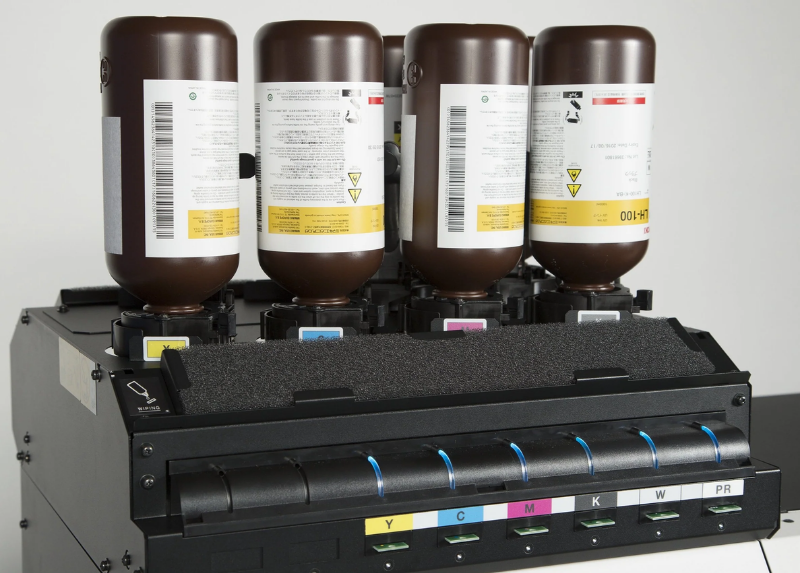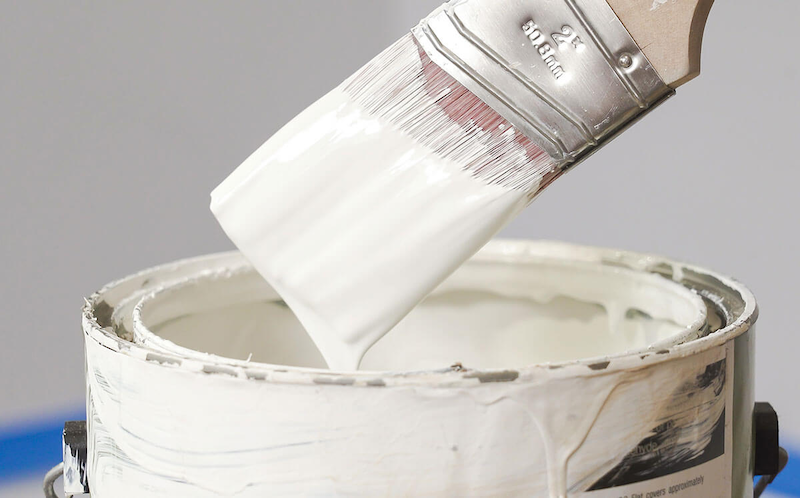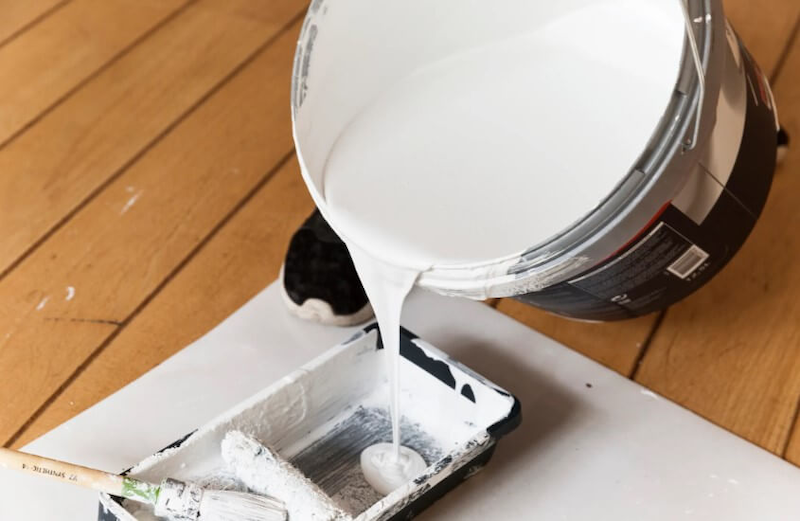TOP 10 Common Types of Printing Ink Used in the Printing Industry Today
01/08/2025
|
Industry news
In the modern printing industry, selecting the right type of ink plays a crucial role in ensuring product quality, optimizing costs, and meeting aesthetic as well as durability requirements. With continuous technological advancement, types of printing ink have become increasingly diverse, ranging from traditional inks like offset and gravure to digital inks such as inkjet and special-effect inks. Each ink type has its own properties, applications, advantages, and disadvantages, making it suitable for specific purposes, substrates, and printing technologies like flexo or gravure printing. Below is an overview of the 10 most commonly used printing inks today, helping you better understand their features and applications in the printing industry.
Liquid Inks
Inkjet Ink
- Characteristics: Liquid ink, usually water-based (dye or pigment), solvent-based, or UV-based. It is sprayed through fine nozzles to create ultra-fine ink droplets on the surface.
- Applications: Posters, banners, photographs, fabrics, T-shirts, and small-scale digital printing products.
- Advantages:
- High resolution, vivid colors – ideal for images and graphics.
- Suitable for short-run and variable data printing.
- Can print on various materials (paper, vinyl, fabric).
- UV and solvent inks are water- and UV-resistant, making them suitable for outdoor printing.
- Disadvantages:
-
- Prone to smudging or fading if not properly preserved (especially dye-based ink).
- Longer drying time for water-based inks.
- Printheads may clog if not maintained regularly.
- Note: Pigment ink is more durable but has less vibrant colors compared to dye ink.
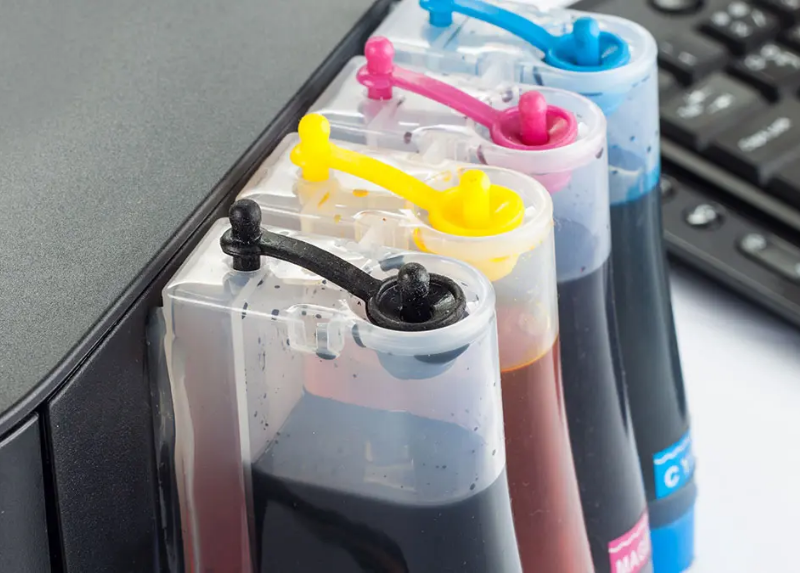
Screen Printing Ink
- Characteristics: Thick, paste-like ink, usually solvent-, water-, or UV-based. It is applied through a mesh screen, with each color typically requiring a separate stencil. Therefore, screen printing is suitable for designs with clearly separated colors.
- Applications: Printing on fabric (T-shirts, banners), glass, ceramics, plastic, and promotional products like balloons and posters.
- Advantages:
- Versatile, can print on various surfaces (fabric, metal, wood).
- Vivid colors, thick and durable ink layer.
- Suitable for outdoor applications.
- Disadvantages:
-
- Slow process, not ideal for mass production.
- Requires drying or curing time.
- Lower precision compared to digital printing.
- Note: Plastisol ink is common in fabric printing but requires heat to cure.
Offset Ink
- Characteristics: Oil- or UV-based ink with high viscosity. It is transferred from a flat plate to a rubber blanket before printing on the surface.
- Applications: Printing books, magazines, brochures, posters, and packaging with high accuracy.
- Advantages:
- Sharp, consistent quality.
- Cost-effective for high-volume printing.
- Compatible with various paper types and adjustable with additives or appropriate ink solvents.
- Disadvantages:
-
- High equipment and setup costs.
- Oil-based inks dry slowly if not UV-cured.
- Not suitable for short runs due to the complex process.
- Note: Offset inks can be customized for transparency, gloss, or heat resistance.
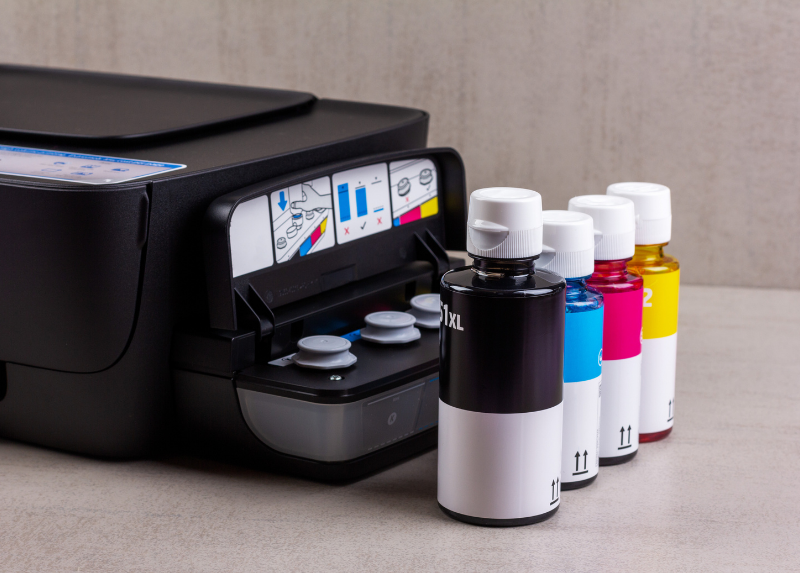
Gravure Ink (Rotogravure Printing)
- Characteristics: Liquid ink with low viscosity, typically solvent- or water-based, formulated for gravure printing. The ink flows into engraved cells on the printing cylinder.
- Applications: Packaging printing (plastic bags, OMO detergent packaging, Bibica), magazines, and labels in large volumes.
- Advantages:
- High quality, vibrant colors, and sharp details.
- Ideal for large-scale, durable printing.
- Fast drying, especially with solvent-based inks.
- Disadvantages:
-
- High cost for cylinder preparation.
- Solvent-based inks require proper ventilation due to volatile organic compound (VOC) emissions.
- Note: Water-based inks are increasingly popular due to environmental friendliness but dry slower. Currently, combining with specialized gravure ink solvents helps accelerate evaporation and ink drying.
Powder Ink (Laser Toner)
- Characteristics: Fine powder form, composed of pigment and polymer, operates on the principle of electrostatics, using heat to melt the toner and fuse it to the paper. Used in laser printers (both monochrome and color), commonly found in office environments.
- Applications: Printing office documents, technical drawings, simple graphics.
- Advantages:
- Fast printing speed, suitable for continuous large-volume printing.
- Sharp, clear print quality ideal for text, tables, and barcodes.
- High durability, resistant to fading or peeling over time.
- Laser printers have low paper jam rates, require minimal maintenance, and operate efficiently to save time.
- Disadvantages:
-
- Not suitable for high-quality photo printing due to color blending limitations.
- Expensive toner cartridges.
- Toner powder may pose environmental concerns.
- Note: Suitable for text and line drawings; not ideal for complex image printing.
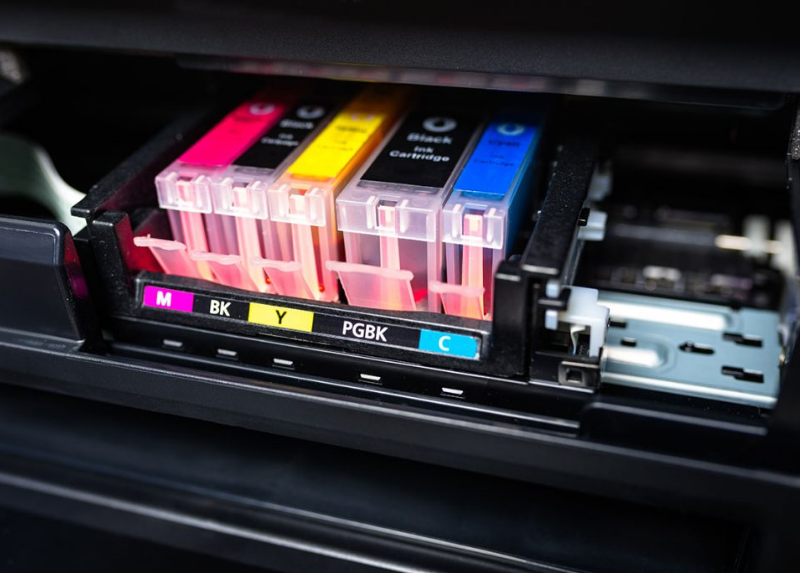
Flexographic Ink (Flexo Ink)
- Characteristics: Liquid form ink with low to medium viscosity, compatible with the anilox roller ink transfer system, a core component of flexographic printing technology. It dries quickly using hot air, UV, or IR drying systems, enhancing printing efficiency.
- Applications: Printing on flexible packaging, corrugated cardboard, labels, plastic films, and cartons.
- Advantages:
- High-speed printing, suitable for continuous packaging production lines.
- Printable on a wide range of materials such as paper, plastic films, metal films, cartons, plastic bags, and labels when combined with suitable flexo ink solvents, delivering high-quality, sharp prints.
- Low cost per unit when printing in large quantities.
- Water-based inks are environmentally friendly, supporting green production trends.
- Disadvantages:
-
- May smudge or result in uneven prints if temperature or pressure is unstable.
- Lower resolution compared to gravure or offset printing.
- Note: UV flexo inks offer greater durability but require specialized equipment.
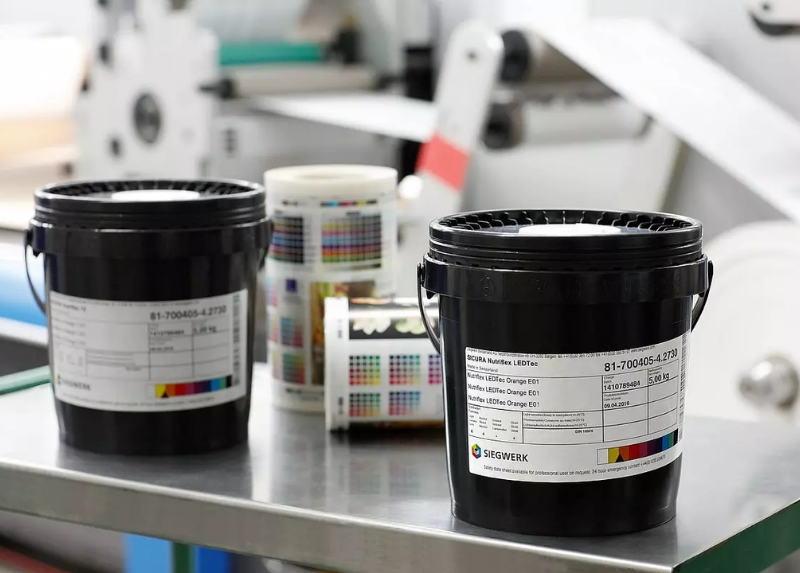
Sublimation Ink (Heat Transfer Ink)
- Characteristics: Dye-based ink that sublimates (solid to gas) when heated (~180–200 °C, pressure 3–5 bar), bonding with polyester or specially coated surfaces.
- Applications: Printing on polyester T-shirts, ceramics, mugs, and hard surfaces like metal or glass.
- Advantages:
- Vibrant colors, high saturation, excellent for detailed photos and graphics.
- Wash-resistant, scratch-resistant, and fade-resistant since the dye embeds into the fibers.
- Ultra-smooth finished surface without a thick or raised feel.
- Ideal for small-batch and personalized printing (names, photos, QR codes, etc.).
- Can achieve full-coverage (all-over) prints on garments, towels, pillowcases without cracking when stretched.
- Disadvantages:
- Limited to polyester or specially coated materials.
- Requires high temperature and specialized equipment.
- Slow drying, sensitive to environmental conditions.
- Note: Sublimation ink delivers vibrant results but is restricted in material compatibility.
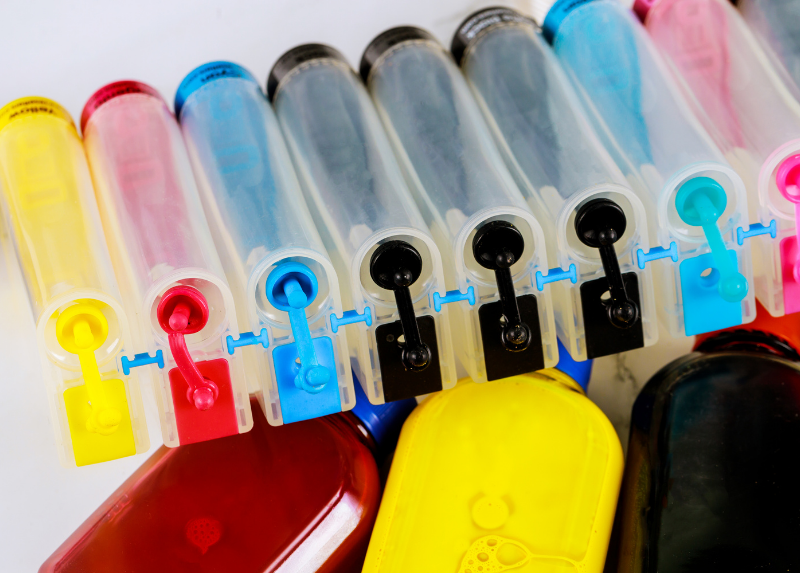
Ribbon Ink (Thermal Transfer Ribbon)
- Characteristics: Film-based ink operating via indirect thermal transfer. The ink on the ribbon is heated by the print head and transferred to the printing surface. There are three main types:
- Wax: Soft, low-cost, easy to print used for standard paper.
- Wax/Resin: Balanced sharpness and medium durability.
- Resin: Strong adhesion, ideal for scratch- and chemical-resistant labels.
- Applications: Printing barcodes, labels, receipts, or metallic colors (foil effects).
- Advantages:
- High durability, scratch-resistant, and fade-resistant especially with resin ribbon.
- Crisp, clear prints ideal for barcodes, serial numbers, and product labels.
- Cost-effective with wax ink is an affordable solution for bulk label printing.
- Can create metallic effects (gold/silver foil) on specialty materials for decorative printing, invitations, and premium packaging.
- Disadvantages:
- Limited color options, typically monochrome.
- Resin ribbons are expensive.
- Requires a thermal transfer printer.
- Note: Resin ribbons are suitable for harsh environments (high heat, freezing).
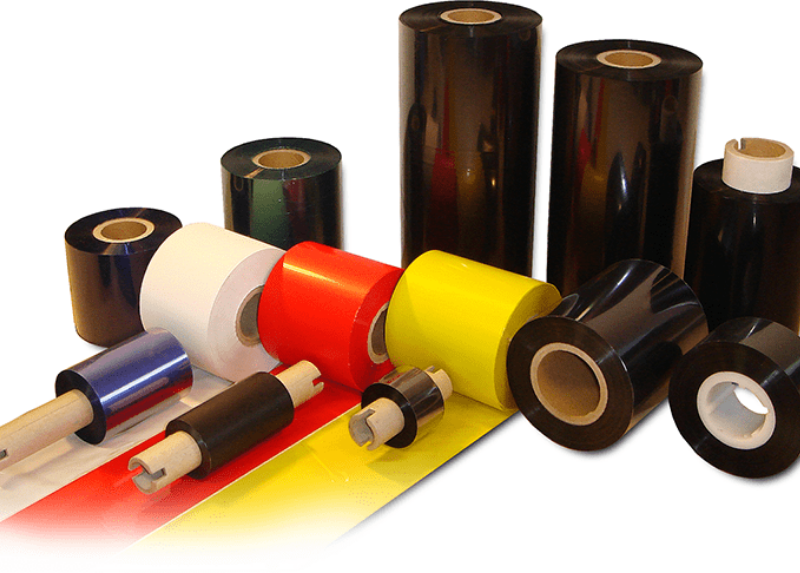
Dye Ink
- Characteristics: Water-soluble ink with small molecules, commonly used in inkjet printers.
- Applications: Photo printing, graphics, and textiles (with sublimation variation).
- Advantages:
- Vivid colors and smooth gradients ideal for photography.
- Lower cost than pigment ink.
- Wide color gamut for creative applications.
- Disadvantages:
-
- Fades easily when exposed to UV light or water.
- Requires coated paper for best results.
- Prone to smudging due to longer drying time.
- Note: Dye ink offers vibrant color output but is less durable than pigment ink.
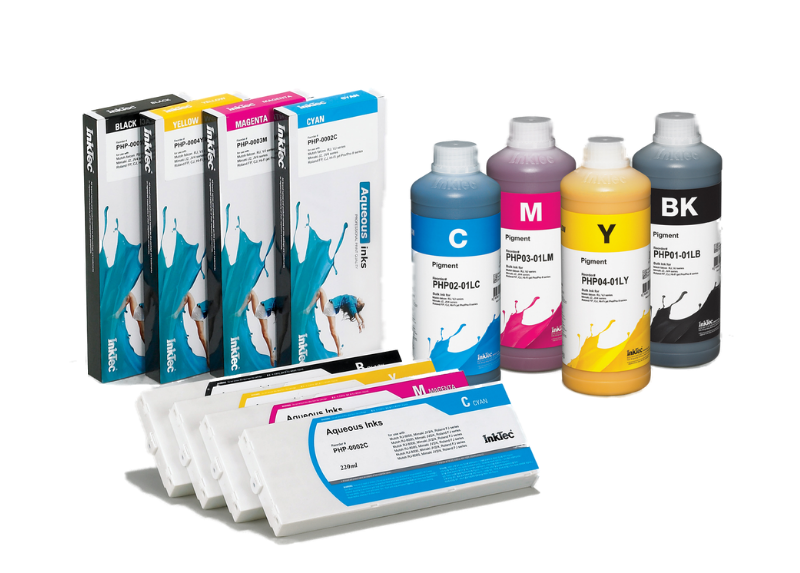
Pigment-Based Ink (Oil-Based Ink)
- Characteristics: Pigment-based ink is an oil-based ink containing insoluble color particles (pigments) dispersed in a solvent. It offers high adhesion, water resistance, UV resistance, and strong color stability when exposed to light or harsh environments.
- Applications: Suitable for outdoor printing products such as banners, signs, posters, plastic cards (PVC), membership cards, and bank cards.
- Advantages:
- Excellent water and UV resistance, resulting in long-lasting, smudge-proof prints even when wet.
- Printable on various materials, including plastics and coated surfaces.
- Strong adhesion, making it fade-resistant in outdoor conditions.
- Produces deeper and sharper black tones compared to dye ink.
- Disadvantages:
- Less vibrant and saturated colors compared to dye ink.
- Higher cost than regular water-based inks.
- May clog print heads if the printer is not used regularly.
- Note: Best suited for high-durability, outdoor applications. Regular printhead maintenance is required to prevent clogging. Not ideal for vibrant color or high-resolution indoor photo printing.
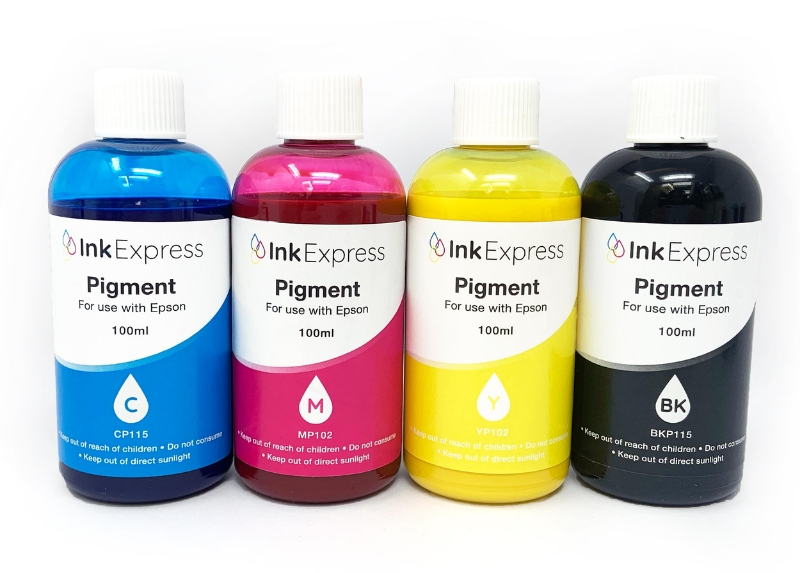
Effect Ink (Specialty Ink)
- Characteristics: Effect ink is a special type of ink containing components such as metallic flakes, fluorescent pigments, glow-in-the-dark additives, or UV-reactive compounds. It is designed to create unique visual effects that regular inks cannot achieve.
- Applications: Used for packaging, labels, promotional materials, and premium products requiring effects like metallic shine or reflectivity.
- Advantages:
-
- Enhances brand recognition through metallic, luminous, or color-shifting effects.
- Conveys a premium and distinctive appearance compared to regular ink.
- Compatible with various printing technologies including Offset, Flexo, Silkscreen, and Gravure.
- Disadvantages:
- Higher cost due to specialized formulations.
- Limited material compatibility (metallic inks may not adhere to all surfaces).
- Often requires additional processing or drying steps.
- Note: Ideal for special-use cases; not commonly used for high-volume printing.
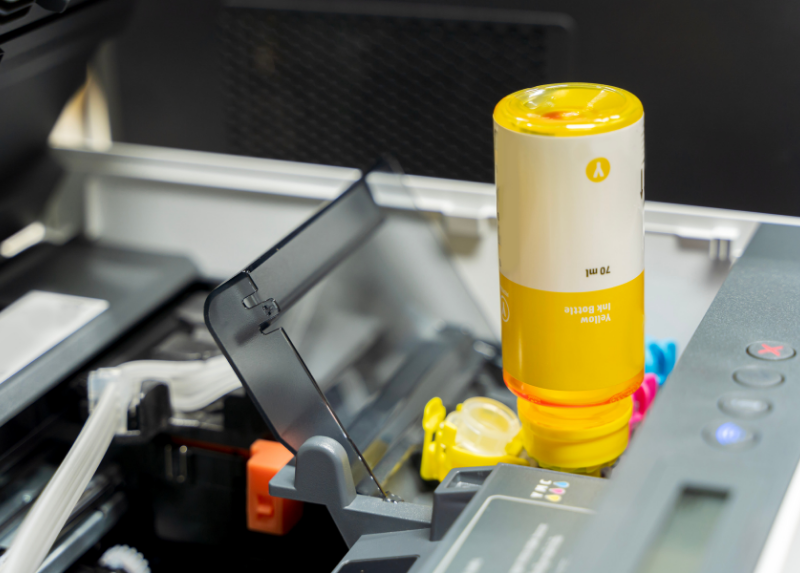
The choice of ink depends on the material, printing technology, durability requirements, and budget. While offset and gravure printing are suitable for high-volume runs, inkjet and sublimation are ideal for personalized needs. The 2025 trend shows the printing industry prioritizing eco-friendly inks such as water-based, UV, and latex inks, while accelerating the adoption of digital printing technologies to meet diverse and sustainable demands.
If you are seeking effective and eco-friendly ink solutions, K-Chem is a trusted partner offering high-quality ink solvent products. We are committed to delivering genuine, industry-standard products and dedicated technical support. Contact K-Chem now for optimal ink formulation consulting to boost your production efficiency and print quality.
K-CHEM VIETNAM CO., LTD
- Address: N6B Street, Lot F, Phu Chanh 1 Industrial Cluster, Phu Chanh Ward, Tan Uyen City, Binh Duong Province, Vietnam
- Tel: +84 274 362 0218
- Email: info@k-chem.vn


